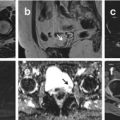and Jurgen J. Fütterer2, 3
(1)
Department of Radiological Sciences, Oncology and Pathology, Sapienza University of Rome, Rome, Italy
(2)
Department of Radiology and Nuclear Medicine, Radboudumc, Nijmegen, The Netherlands
(3)
MIRA Institute for Biomedical Technology and Technical Medicine, University of Twente, Enschede, The Netherlands
Mesoblastic Nephroma
Mesoblastic nephroma is the most common renal tumor identified in the neonatal period and the most frequent benign renal tumor in childhood. Solid, homogeneous, usually large tumor that could mimic a Wilms’ tumor. Hemorrhage and necrosis develop in the aggressive and malignant variants, although cystic degeneration is not common.
Adult mesoblastic nephroma differs from the pediatric one, standing as a different disease, could also mimic other tumors such as cystic hamartomas and adrenal tumors.
The signal intensity characteristics are similar to those of the normal renal parenchyma. The lesion appears isointense to the kidney on T1-weighted images. The signal is lower than that of the surrounding fat and higher than that of the renal medulla. The mass shows increased signal on T2-weighted images. Contrast-enhanced MRIs show no or minimal contrast enhancement in the mass.
Megaureter
The term megaureter may refer to two conditions: first one, it represents a sequela of uncorrected massive chronic reflux and can also affect the bladder, whereas the second one is a congenital condition (the width exceeds 10 mm).
The condition is more often detected in children than adults and is more common on the left side.
US findings show a massive dilation, consisting in an anechoic signal flanked above and below by two hyper/isoechogenic strips which represent the ureter stretched walls.
CT/MRI well assesses this anomaly. CT without contrast agent shows an enlarged lumen of the ureter.
CT urography protocol allows to assess a hyperdense signal originating from the lumen itself, caused by the stagnation of contrast agent.
MRI findings are similar to CT, except that on heavily T2-weighted sequences it could be possible to evaluate lumen swelling thanks to fluid stasis which gives back a strong hyperintense signal, so no contrast could be required.
Metastases to Kidney
Metastases to the kidneys are common, with multiple foci and bilateral involvement typical.
Usual metastases to kidney involved melanoma, thyroid carcinoma, liver, colon, lung and breast cancer, and ovarian carcinoma.
Renal metastases have a CT, US, and MRI appearance similar to that of renal cell carcinoma or lymphoma.
CT findings reveal that metastases are hypodense and inhomogeneous on unenhanced CT, whereas contrast-enhanced CT reveals most to have inhomogeneous enhancement. Most enhance less than normal renal parenchyma. Metastatic thyroid carcinomas, on the other hand, tend to be hyperdense and have variable contrast enhancement. Renal vein invasion is rare with metastatic disease.
Multicystic Dysplastic Kidney
Multicystic dysplastic kidney (MCDK) or multicystic dysplasia is a condition, which occurs during the fetal life, consisting in an anomaly of kidney development. It is a form of renal dysplasia that is secondary to altered metanephric differentiation during embryogenesis. The kidney itself consists of irregular cysts of varying sizes and has no function. This condition could be only unilateral because complete bilateral involvement is incompatible with life. Depending on the extent of involvement, dysplasia is limited to the infundibula, renal pelvis, and proximal ureter, or it involves a kidney to the point that dilated calyces appear as intrarenal cysts. Segmental multicystic dysplasia occurs in a setting of a duplex collecting system.
A multicystic dysplastic kidney is commonly associated with vesicoureteral reflux in the contralateral kidney and with a posterior location of the urethral valves.
Stay updated, free articles. Join our Telegram channel

Full access? Get Clinical Tree




